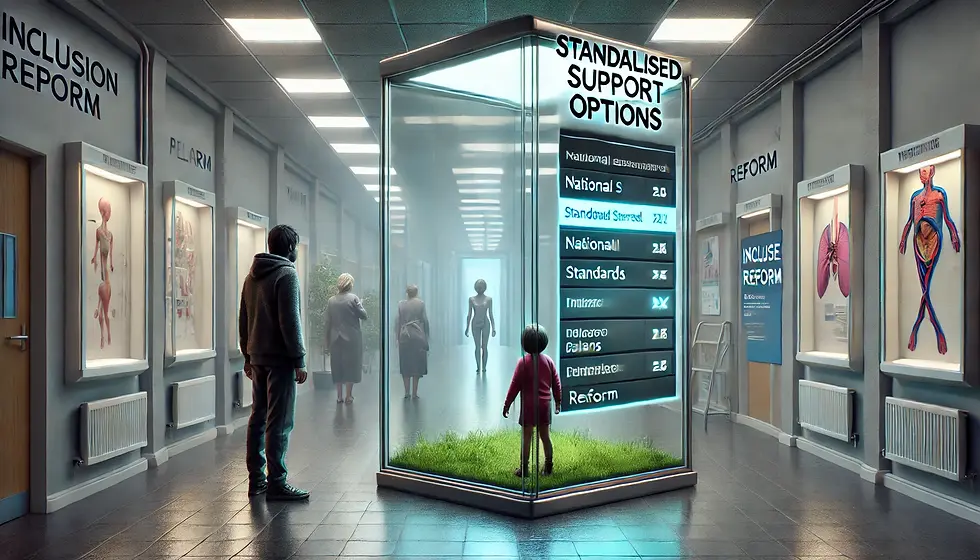EHCPs Under Threat: What We’re Really Losing, and How We Can Do Better
- Jarone Macklin-Page
- Jul 8
- 4 min read

The government is considering scrapping EHCPs, but the system is already failing many SEND children. Here’s what we’re really losing, what’s broken, and how to build something better that actually works.
🧩 The Promise That Fell Short
Education, Health and Care Plans (EHCPs) were meant to be the great equaliser, offering children with additional needs a path to meaningful support in school. For many families, they’re the only hope of being heard.
But the reality doesn’t match the promise. And now, with formal government proposals to scrap EHCPs in their current form, replacing them with a standardised 'tailored list of support', we’re left wondering: what are we really losing? And more urgently, what could we build in its place?

⚠️ EHCPs in Practice: The Truth Behind the Process
On paper, an EHCP should mean a personalised, legally binding package of support. In practice:
Families wait an average of 40+ weeks for assessment, well beyond the 20-week legal limit
95% of appeals against EHCP decisions are won by parents, showing how flawed the process is
Support is inconsistent, often limited to a teaching assistant “hovering” in class
Reviews are missed or delayed, with little accountability or tracking of real progress
Far too often, parents become project managers and advocates, chasing a system that seems designed to wear them down.

🧭 What the Government Is Proposing, and Why It’s Not Enough
The SEND and AP Improvement Plan proposes several changes, including:
Replacing EHCPs with a nationally standardised "tailored list of support"
Introducing national standards to reduce the postcode lottery
Expanding teacher training in SEND and improving inclusive practice
Streamlining the process through digitised systems and Local Inclusion Plans
These ideas sound promising, but risk falling short in practice. A rigid menu of support may limit personalisation. General SEND training can’t replace specialist input, especially in large, under-resourced classrooms. And streamlining must not come at the cost of real-life impact.
The intent is there, but without deep structural reform, the outcomes may still fail the children who need help most.

🍎 Let’s Be Clear: Teachers Aren’t the Problem
I want to say this loud and clear: this is not the fault of teachers.
The vast majority are doing an extraordinary job in impossible conditions, juggling overcrowded classrooms, limited resources, and rising needs with very little training or support.
We can’t keep pushing the burden onto already over-stretched schools. The system is what’s broken, not the people in it.

💸 A Broken System Burning Through Budget
The EHCP system costs billions annually and yet still fails the children it’s meant to help. Much of the funding goes toward:
Panels, reports, and assessments
Legal disputes and appeals
Administrative costs, not frontline support
Despite this investment, outcomes remain poor:
Young people with EHCPs are six times more likely to be excluded
Only 39% of adults who had an EHCP are in paid employment by age 30, compared to 63% of their peers without SEND (source)
A large proportion leave school with low qualifications and low confidence
(And that includes people with dyslexia, ADHD, and other learning difficulties, not just those with learning disabilities, who make up a much smaller portion of the EHCP population.)
If this were any other system, we’d have redesigned it already.

🏫 What Could Work Better (And Cost Less)
Rather than scrapping EHCPs without a thoughtful replacement, we need to rebuild around what actually works. Here’s my vision:
✅ 1. Move to a Flexible, Hybrid Learning Model
Some children with additional needs thrive outside the classroom but have no formal options. A hybrid model, combining in-school attendance with home-based, project-led or online learning, could:
Reduce pressure on schools
Cater to different processing styles
Improve attendance and engagement
Flexibility should be seen as a strength, not a concession.
✅ 2. Build Support Plans With Parents, Not Just For Them
Parents know their children best. Instead of isolating families or making them battle the system, schools and local authorities should co-create Support Partnership Plans:
Simple, clear documents based on real needs
Reviewed every term with input from home
A shared roadmap, not a legal battleground
✅ 3. Equip Schools, Don’t Overburden Them
Funding must go directly to the classroom, not admin offices. This means:
Universal access to specialist training for every teacher
School-wide use of assistive tech (dictation, text-to-speech, visual planners)
Smaller intervention groups and more practical, targeted tools
Let’s spend less on paperwork and more on pupils.
✅ 4. Make Early Support the Default
Currently, children often need to “fail” before help kicks in. We should flip that:
If a child shows persistent difficulties, support starts immediately
No diagnosis or lengthy waitlist required
Outcomes are tracked and support is adjusted dynamically
Early help saves money and changes lives.

🌱 There Is a Better Way Forward
We’re at a crossroads. Dismantling EHCPs without a thoughtful replacement is not just short-sighted, it’s dangerous.
But this moment could also be an opportunity.
Imagine a system where:
Support is proactive and personal
Families are partners, not adversaries
Teachers are trusted and equipped
And every child, regardless of need, can access an education that works for them
That future is possible. But only if we stop patching a broken process and start reimagining what inclusion really looks like.

✍️ Final Thought
If EHCPs disappear tomorrow, many will mourn the idea of what they promised, rather than what they delivered.
Let’s stop pretending the current model is working. It isn’t. But let’s also reject the idea that nothing better is possible.
Because when we put outcomes above admin, and relationships above red tape, we don’t just save money.
We build futures.
💡 Want to support change?
Share this article with your network. Talk to your school. Ask your MP what’s next if EHCPs go. And if you're an employer or educator, start asking better questions about how we support people who think differently.
Let’s build something better, together.



Comments